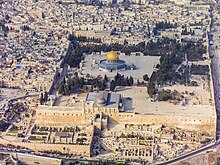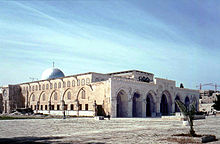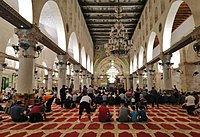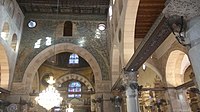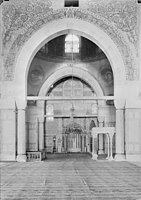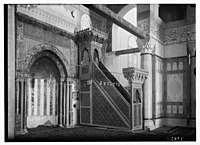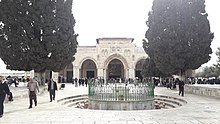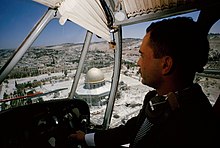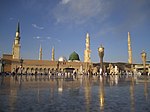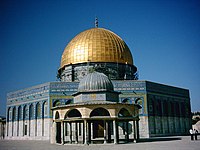Al-Aqsa Mosque
Al-Aqsa Mosque
Etymology
Definition
History
Pre-construction
Construction by the Umayyads
Earthquakes and reconstructions
Modern era
Architecture
Dome
Facade and porch
Interior
Religious significance in Islam
Isra and Mi'raj
First qibla
Religious status
Current situations
Administration
Sheikh Abu Yusuf Sneia, Sheikh Ali Al Abbasi, Sheikh Sa'eed Qalqeeli, Sheikh Walid
Access
Excavations
Conflicts
See also
- Haram (site) – Islamic holy place (Sanctuary)
- Islamic architecture – Architectural styles of buildings associated with Islam
- Islam in Israel – Overview of the role of Islam and Muslims in Israel
- Islam in the Palestinian territories
- Jordanian art – History of the arts in the Kingdom of Jordan
- List of the oldest mosques in the world
- Al-Masjid an-Nabawi
- Mosque of Omar (Jerusalem) – Mosque in the Christian Quarter of Jerusalem
- Palestinian nationalism – Movement for self-determination and sovereignty of Palestine
- Religious significance of the Syrian region
- History of medieval Arabic and Western European domes – Domes in religious architecture
Notes
References
- ^ Al-Ratrout, H. A., The Architectural Development of Al-Aqsa Mosque in the Early Islamic Period, ALMI Press, London, 2004.
- ^ a b Buchanan, Allen (2004). States, Nations, and Borders: The Ethics of Making Boundaries. Cambridge University Press. ISBN 0-521-52575-6.
- ^ "Arab states neglect Al-Aqsa says head of Jerusalem Waqf". Al-Monitor. 5 September 2014. Retrieved 5 April 2016.
- ^ The Archaeology of the Holy Land: From the Destruction of Solomon's Temple to the Muslim Conquest, Cambridge University Press, Jodi Magness, page 355
- ^ a b "Al-Aqsa Mosque, Jerusalem". Atlas Travel and Tourist Agency. Archived from the original on 26 July 2008. Retrieved 29 June 2008.
- ^ "Lailat al Miraj". BBC News. BBC MMVIII. Retrieved 29 June 2008.
- ^ Grabar 2000, p. 203.
- ^ Schieck, Robert (2008) in Geographical Dimension of Islamic Jerusalem, Cambridge Scholars Publishing; see also Omar, Abdallah (2009) al-Madkhal li-dirasat al-Masjid al-Aqsa al-Mubarak, Beirut: Dar al-Kotob al-Ilmiyaah; also by the same author the Atlas of Al-Aqsa Mosque (2010)
- ^ Jarrar 1998, p. 85.
- ^ "Al-Aqsa Mosque". Al Habtoor Group. Al-Shindagah.com. 2007.
- ^ Mahdi Abdul Hadi: "Al-Aqsa Mosque, also referred to as Al-Haram Ash-Sharif (the Noble Sanctuary), comprises the entire area within the compound walls (a total area of 144,000 m2) – including all the mosques, prayer rooms, buildings, platforms and open courtyards located above or under the grounds – and exceeds 200 historical monuments pertaining to various Islamic eras. According to Islamic creed and jurisprudence, all these buildings and courtyards enjoy the same degree of sacredness since they are built on Al-Aqsa’s holy grounds. This sacredness is not exclusive to the physical structures allocated for prayer, like the Dome of the Rock or Al-Qibly Mosque (the mosque with the large silver dome)"
Mahdi Abdul Hadi Archived 16 February 2020 at the Wayback Machine Palestinian Academic Society for the Study of International Affairs; Tim Marshall: "Many people believe that the mosque depicted is called the Al-Aqsa; however, a visit to one of Palestine's most eminent intellectuals, Mahdi F. Abdul Hadi, clarified the issue. Hadi is chairman of the Palestinian Academic Society for the Study of International Affairs, based in East Jerusalem. His offices are a treasure trove of old photographs, documents, and symbols. He was kind enough to spend several hours with me. He spread out maps of Jerusalem's Old City on a huge desk and homed in on the Al-Aqsa compound, which sits above the Western Wall. "The mosque in the Al- Aqsa [Brigades] flag is the Dome of the Rock. Everyone takes it for granted that it is the Al-Aqsa mosque, but no, the whole compound is Al-Aqsa, and on it are two mosques, the Qibla mosque and the Dome of the Rock, and on the flags of both Al-Aqsa Brigades and the Qassam Brigades, it is the Dome of the Rock shown", he said." Tim Marshall (2017). A Flag Worth Dying For: The Power and Politics of National Symbols. Simon and Schuster. pp. 151–. ISBN 978-1-5011-6833-8. - ^ Hartsock, Ralph (27 August 2014). "The temple of Jerusalem: past, present, and future". Jewish Culture and History. 16 (2): 199–201. doi:10.1080/1462169X.2014.953832. S2CID 162641910.
- ^ Michigan Consortium for Medieval and Early Modern Studies (1986). Goss, V. P.; Bornstein, C. V. (eds.). The Meeting of Two Worlds: Cultural Exchange Between East and West During the Period of the Crusades. Vol. 21. Medieval Institute Publications, Western Michigan University. p. 208. ISBN 0918720583.
- ^ a b Ehud Netzer (October 2008). Architecture of Herod, the Great Builder. Baker Academic. pp. 161–171. ISBN 978-0-8010-3612-5.
- ^ Avigad, Nahman (1977). "A Building Inscription of the Emperor Justinian and the Nea in Jerusalem". Israel Exploration Journal. 27 (2/3): 145–151. JSTOR 27925620.
- ^ Schick, Robert (2007). "Byzantine Jerusalem". In Kafafi, Zeidan; Schick, Robert (eds.). Jerusalem before Islam. Archaeopress. p. 175. ISBN 978-1-4073-0141-9.
- ^ Liphschitz, N.; Biger, G.; Bonani, G.; Wolfli, W. (1997). "Comparative Dating Methods: Botanical Identification and 14C Dating of Carved Panels and Beams from the Al-Aqsa Mosque in Jerusalem". Journal of Archaeological Science. 24 (11): 1045–1050. doi:10.1006/jasc.1997.0183.
- ^ a b c Yuval Baruch, Ronny Reich & Débora Sandhaus. "A Decade of Archaeological Exploration on the Temple Mount, Tel Aviv". Tel Aviv. 45 (1): 3–22. doi:10.1080/03344355.2018.1412057. S2CID 166015732.
- ^ a b c d e Elad, Amikam. (1995). Medieval Jerusalem and Islamic Worship Holy Places, Ceremonies, Pilgrimage BRILL, pp. 29–43. ISBN 90-04-10010-5.
- ^ a b c d le Strange, Guy. (1890). Palestine under the Moslems, pp. 80–98.
- ^ a b Grafman and Ayalon, 1998, pp. 1–15.
- ^ a b c d e f g h Ma'oz, Moshe and Nusseibeh, Sari. (2000). Jerusalem: Points of Friction, and Beyond BRILL. pp. 136–138. ISBN 90-411-8843-6.
- ^ a b Al-Aqsa Mosque Archived 3 January 2009 at the Wayback Machine Archnet Digital Library.
- ^ Jeffers, 2004, pp. 95–96.
- ^ "The travels of Nasir-i-Khusrau to Jerusalem, 1047 C.E". Homepages.luc.edu. Archived from the original on 19 July 2011. Retrieved 13 July 2010.
- ^ Pringle, 1993, p. 403.
- ^ Boas, 2001, p. 91.
- ^ Hancock, Lee. Saladin and the Kingdom of Jerusalem: the Muslims recapture the Holy Land in AD 1187. 2004: The Rosen Publishing Group. ISBN 0-8239-4217-1
- ^ Madden, 2002, p. 230.
- ^ a b Al-Aqsa Guide Archived 6 October 2008 at the Wayback Machine Friends of Al-Aqsa 2007.
- ^ Pappe, Ilan (2012). "Chapter 2: In the Shadow of Acre and Cairo: The Third Generation". The Rise and Fall of a Palestinian Dynasty: The Huyaynis 1700 – 1948. Saqi Books. ISBN 978-0-86356-801-5.
- ^ Hamilton (1949), pp. 1–2
- ^ a b Yuvaz, 1996, pp. 149–153.
- ^ "The Burning of Al-Aqsa". Time. 29 August 1969. p. 1. Archived from the original on 28 June 2011. Retrieved 1 July 2008.
- ^ "Madman at the Mosque". Time. 12 January 1970. Archived from the original on 30 October 2010. Retrieved 3 July 2008.
- ^ Esposito, 1998, p. 164.
- ^ Dumper, 2002, p. 44.
- ^ Sprinzak 2001, pp. 198–199.
- ^ OpenDocument Letter Archived 28 June 2011 at the Wayback Machine Dated 18 January 1988 from the Permanent Observer for the Palestine Liberation Organization to the United Nations Office at Geneva Addressed to the Under-Secretary-General for Human Rights Ramlawi, Nabil. Permanent Observer of the Palestine Liberation Organization to the United Nations Office at Geneva.
- ^ Palestine Facts Timeline, 1963–1988 Archived 29 September 2008 at the Wayback Machine Palestinian Academic Society for the Study of International Affairs.
- ^ Dan Izenberg, The Jerusalem Post, 19 July 1991
- ^ a b Amayreh, Khaled. Catalogue of provocations: Israel's encroachments upon the Al-Aqsa Mosque have not been sporadic, but, rather, a systematic endeavor Archived 15 November 2008 at the Wayback Machine Al-Ahram Weekly. February 2007.
- ^ "Provocative' mosque visit sparks riots". BBC News. BBC MMVIII. 28 September 2000. Retrieved 1 July 2008.
- ^ Khaled Abu Toameh. "How the war began". Archived from the original on 28 March 2006. Retrieved 29 March 2006.
- ^ "In a Ruined Country". The Atlantic Monthly Online. September 2005.
- ^ Dean, 2003, p. 560.
- ^ "Israeli occupation forces breach Al-Aqsa Mosque for the first time since 1967". Middle East Monitor. Archived from the original on 23 December 2014. Retrieved 23 December 2014.
- ^ a b c d e f Al-Aqsa Mosque Life in the Holy Land.
- ^ Gonen, 2003, p. 95.
- ^ a b Al-Aqsa Mosque Restoration Archived 3 January 2009 at the Wayback Machine Archnet Digital Library.
- ^ Necipogulu, 1998, p. 14.
- ^ Hillenbrand, Carolle. (2000). The Crusades: The Islamic Perspective Routeledge, p. 382 ISBN 0-415-92914-8.
- ^ a b Al-Aqsa Mosque, Jerusalem Sacred Destinations.
- ^ a b c d The Encyclopaedia of Islam; By H. A. R. Gibb, E. van Donzel, P. J. Bearman, J. van Lent; p.151
- ^ a b Oweis, Fayeq S. (2002) The Elements of Unity in Islamic Art as Examined Through the Work of Jamal Badran Universal-Publishers, pp. 115–117. ISBN 1-58112-162-8.
- ^ a b Wilson, Ashleigh. Lost skills revived to replicate a medieval minbar. The Australian. 2008-11-11. Access date: 8 July 2011.
- ^ Mikdadi, Salwa D. Badrans: A Century of Tradition and Innovation, Palestinian Art Court Archived 4 January 2009 at the Wayback Machine Riweq Bienalle in Palestine.
- ^ Sahih al-Bukhari, 5:58:226
- ^ "A history of the Al Asqa Mosque". Arab World Books.
- ^ a b Buchanan, Allen (2004). States, Nations, and Borders: The Ethics of Making Boundaries. Cambridge University Press. ISBN 0-521-52575-6.
- ^ Brooke Olson Vuckovic. Heavenly journeys, earthly concerns (2004). Routledge.
- ^ Richard C. Martin; Said Amir Arjom; Marcia Hermansen; Abdulkader Tayob; Rochelle Davis; John Obert Voll, eds. (2 December 2003). Encyclopedia of Islam and the Muslim World. Macmillan Reference USA. p. 482. ISBN 978-0-02-865603-8.
- ^ Religion and the Arts, Volume 12. 2008. pp. 329–342
- ^ Vuckovic, Brooke Olson (30 December 2004). Heavenly Journeys, Earthly Concerns: The Legacy of the Mi'raj in the Formation of Islam (Religion in History, Society and Culture). Routledge. ISBN 978-0-415-96785-3.
- ^ Sahih al-Bukhari, 9:93:608
- ^ Historic Cities of the Islamic World edited by Clifford Edmund Bosworth P: 226
- ^ Frederick S. Colby (6 August 2008). Narrating Muhammad's Night Journey: Tracing the Development of the Ibn 'Abbas Ascension Discourse. SUNY Press. p. 15. ISBN 978-0-7914-7788-5.
{{cite book}}: External link in|author= - ^ Wāqidī, Muḥammad ibn ʻUmar, or 748-823 (2011). The life of Muḥammad : al-Wāqidī's Kitāb al-maghāzī. Rizwi Faizer, Amal Ismail, Abdulkader Tayob, Andrew Rippin. Milton Park, Abingdon, Oxon: Routledge. p. 469. ISBN 978-0-415-57434-1. OCLC 539086931.
When he desired to turn back to Medina, he set out from al-Jirrana on Wednesday night, twelve nights remaining in Dhul-Qada. He donned his ihram at the furthest mosque (al-masjid al-Aqsa), which was below the wadi on a remote slope. It was the place of prayer of the Messenger of God when he was in al-Jiranna. As for the closest mosque, a man from the Quraysh built it and he marked that place with it.
- ^ "Israel applauds Egyptian writer's remarks on Jerusalem". www.aljazeera.com. Retrieved 2 February 2022.
- ^ Kasraoui, Safaa. "Saudi Lawyer Claims Al Aqsa Mosque Is In Saudi Arabia, Not Jerusalem". www.moroccoworldnews.com/. Retrieved 2 February 2022.
- ^ Shah, 2008, p. 39.
- ^ Raby, 2004, p. 298.
- ^ Patel, 2006, p. 13.
- ^ Asali, 1990, p. 105.
- ^ a b c Mosaad, Mohamed. Bayt al-Maqdis: An Islamic Perspective pp. 3–8
- ^ The Furthest Mosque, The History of Al – Aqsa Mosque From Earliest Times Mustaqim Islamic Art & Literature. 5 January 2008.
- ^ el-Khatib, Abdallah (1 May 2001). "Jerusalem in the Qur'ān". British Journal of Middle Eastern Studies. 28 (1): 25–53. doi:10.1080/13530190120034549. S2CID 159680405. Archived from the original on 9 December 2012. Retrieved 17 November 2006.
- ^ Talhami, Ghada Hashem (February 2000). "The Modern History of Islamic Jerusalem: Academic Myths and Propaganda". Middle East Policy Journal. Blackwell Publishing. VII (14). ISSN 1061-1924. Archived from the original on 16 November 2006. Retrieved 17 November 2006.
- ^ Silverman, Jonathan (6 May 2005). "The opposite of holiness". Ynetnews. Retrieved 17 November 2006.
- ^ Doninger, Wendy (1 September 1999). Merriam-Webster's Encyclopedia of World Religions. Merriam-Webster. p. 70. ISBN 0-87779-044-2.
- ^ Important Sites: Al-Aqsa Mosque
- ^ "Resolution No. 2/2-IS". Second Islamic Summit Conference. Organisation of the Islamic Conference. 24 February 1974. Archived from the original on 14 October 2006. Retrieved 17 November 2006.
- ^ Social Structure and Geography Palestinian Academic Society for the Study of International Affairs.
- ^ Yaniv Berman, "Top Palestinian Muslim Cleric Okays Suicide Bombings", Media Line, 23 October 2006.
- ^ Camp David Projections Archived 11 January 2012 at the Wayback Machine Palestinian Academic Society for the Study of International Affairs. July 2000.
- ^ a b Mohammed Mar'i (14 August 2010). "Thousands barred from praying in Al-Aqsa". Arab News. Archived from the original on 18 November 2010.
- ^ a b "Fresh clashes mar al-Aqsa prayers". BBC News. 9 October 2009.
- ^ "Israel police, fearing unrest, limit al-Aqsa worship". i24news. 14 April 2014. Archived from the original on 10 August 2016.
- ^ "Israel boosts security in east Jerusalem".
- ^ Ramadan prayers at al-Aqsa mosque BBC News. 5 September 2008.
- ^ "Report: Israel, Jordan in Talks to Readmit non-Muslim Visitors to Temple Mount Sites". Haaretz. 30 June 2015.
- ^ Finkelstein, Israel (26 April 2011). "In the Eye of Jerusalem's Archaeological Storm". The Jewish Daily Forward. Retrieved 2 May 2011.
- ^ Abdel-Latif, Omayma (8 August 2001). "'Not impartial, not scientific': As political conflict threatens the survival of monuments in the world's most coveted city, Omayma Abdel-Latif speaks to UNESCO's special envoy to Jerusalem". Al-Ahram Weekly. Archived from the original on 5 June 2011. Retrieved 15 July 2011.
- ^ Lis, Jonathan (2 December 2007). "Majadele: Jerusalem mayor knew Mugrabi dig was illegal". Haaretz. Archived from the original on 12 June 2008. Retrieved 1 July 2008.
- ^ Rabinovich, Abraham (8 February 2007). "Palestinians unite to fight Temple Mount dig". The Australian. Archived from the original on 16 January 2009. Retrieved 1 July 2008.
- ^ Friedman, Matti (14 October 2007). "Israel to resume dig near Temple Mount". USA Today. Retrieved 1 July 2008.
- ^ Aseel Jundi (24 April 2021). "In Jerusalem, Ramadan sees heightened tensions at Al-Aqsa Mosque compound". Middle East Eye.
- ^ "Israel criticized for silencing call to prayer from Al-Aqsa Mosque". 16 April 2021. Retrieved 25 April 2021.
- ^ Hamann, Jasper (16 April 2021). "Friday Prayers Draw 70,000 Palestinians to Al Aqsa Mosque". Retrieved 25 April 2021.
- ^ "Scores injured in fresh night of Jerusalem clashes". The Guardian. 9 May 2021.
- ^ "Explainer: Jerusalem tense over evictions and holidays". Reuters. 10 May 2021.
- ^ Fabian, Emanuel; Boxerman, Aaron; staff, T. O. I. "Over 150 injured, 400 arrested as Palestinians clash with cops on Temple Mount". www.timesofisrael.com. Retrieved 15 April 2022.
- ^ "Israeli forces raid Al-Aqsa Mosque, over 90 Palestinians injured". Al Jazeera.
- ^ "Al-Aqsa mosque: At least 90 injured as Israeli police clash with Palestinians". Sky News.
Bibliography
- 'Asali, Kamil Jamil (1990). Jerusalem in History. Interlink Books. ISBN 1-56656-304-6.
- Auld, Sylvia (2005). "The Minbar of al-Aqsa: Form and Function". In Hillenbrand, R (ed.). Image and Meaning in Islamic Art. London: Altajir Trust. pp. 42–60.
- Boas, Adrian (2001). Jerusalem in the Time of the Crusades: Society, Landscape and Art in the holy city under Frankish rule. Routledge. ISBN 0-415-23000-4.
- Dean, Lucy (2003). The Middle East and North Africa 2004. Routledge. ISBN 1-85743-184-7.
- Dumper, Michael (2002). The Politics of Sacred Space: The Old City of Jerusalem in the Middle East. Lynne Rienner Publishers. ISBN 1-58826-226-X.
- Esposito, John L. (1998). Islam and Politics. Syracuse University Press. ISBN 0-8156-2774-2.
- Gonen, Rivka (2003). Contested Holiness. KTAV Publishing House. ISBN 0-88125-799-0.
- Grabar, Oleg (2000). "The Haram al-Sharif: An Essay in Interpretation" (PDF). Bulletin of the Royal Institute for Inter-Faith Studies. Constructing the Study of Islamic Art. 2 (2). Archived from the original (PDF) on 14 April 2016. Retrieved 20 January 2019.
- Hamilton, R. W. (1949). The structural history of the Aqsa Mosque: a record of archaeological gleanings from the repairs of 1938–1942. London: Oxford University Press (for the Government of Palestine by Geoffrey Cumberlege). OCLC 913480179.
- Jacobs, Daniel (2009). Jerusalem. Penguin. ISBN 978-1-4053-8001-0.
- Jarrar, Sabri (1998). "Suq al-Ma'rifa: An Ayyubid Hanbalite Shrine in Haram al-Sharif". In Necipoğlu, Gülru (ed.). Muqarnas: An Annual on the Visual Culture of the Islamic World (Illustrated, annotated ed.). Brill. ISBN 978-90-04-11084-7.
- Jeffers, H. (2004). Contested Holiness: Jewish, Muslim, and Christian Perspective on the Temple. KTAV Publishing House. ISBN 978-0-88125-799-1.
- Madden, Thomas F. (2002). The Crusades: The Essential Readings. Blackwell Publishing. ISBN 0-631-23023-8.
- Marouf, Abdullah. المدخل إلى دراسة المسجد الأقصى المبارك [Introduction to the study of the Blessed Aqsa Mosque] (in Arabic) (1st 2006 ed.). دار العلم للملايين.
- Meri, Josef W.; Bacharach, Jeri L. (2006). Medieval Islamic civilization: An Encyclopedia. Taylor and Francis. ISBN 0-415-96691-4.
- Netzer, Ehud (2008). The Architecture of Herod, the Great Builder. Baker Academic. ISBN 978-0-8010-3612-5.
- Patel, Ismail (2006). Virtues of Jerusalem: An Islamic Perspective. Al-Aqsa Publishers. ISBN 0-9536530-2-1.
- Pringle, Denys (1993). The Churches of the Crusader Kingdom of Jerusalem: Volume 3, The City of Jerusalem: A Corpus. Cambridge University Press. ISBN 978-0-521-39038-5.
- Raby, Julian (2004). Essays in Honour of J. M. Rogers. Brill. ISBN 90-04-13964-8.
- Shah, Niaz A. (2008). Self-defense in Islamic and international law. Macmillan. ISBN 978-0-230-60618-0.
- Sprinzak, Ehud (1996). "From Messianic Pioneering to Vigilante Terrorism: The Case of the Gush Emunim Underground". In Rapoport, David (ed.). Inside Terrorist Organizations. Brill. ISBN 90-04-10633-2.
- Yavuz, Yildirim (2001). "The Restoration Project of the Masjid al-Aqsa by Mimar Kemalettin (1922–26)". In Necipoğlu, Gülru (ed.). Muqarnas, Volume 13: An Annual on the Visual Culture of the Islamic World. ISBN 0-7146-8179-2.
External links
| Wikimedia Commons has media related to Al-Qibli Chapel. |
ওয়েলফশন মানবকল্যাণ সংঘ যা বিশ্বের কল্যাণকামী মানুষের সম্মিলিত সংগঠন। যার লক্ষ্য কল্যাণকামীদের একত্রিত করা,শিক্ষা অনুরাগী, কল্যাণ অনুরাগী, জ্ঞান অনুরাগী এবং কল্যাণের জন্য একতাবদ্ধ হতে আকাঙ্ক্ষীদের নিয়ে সততা ও ন্যায়নিষ্ঠার সাথে একতাবদ্ধ হয়ে মানবতার কল্যাণে কাজ করে, সুন্দর সমাজ গড়া। শিক্ষা সচেতনতার প্রচার করা। বিশ্বে শিক্ষা, সততা ও কল্যাণের প্রসার এবং উন্নয়নের মাধ্যমে মানুষের জীবন মানের উন্নয়ন ঘটানো ওয়েলফশনের প্রধান লক্ষ । Welfare,Education,Lead,Friend,Truth,Indagator,Organization,Necessary WELFTION





